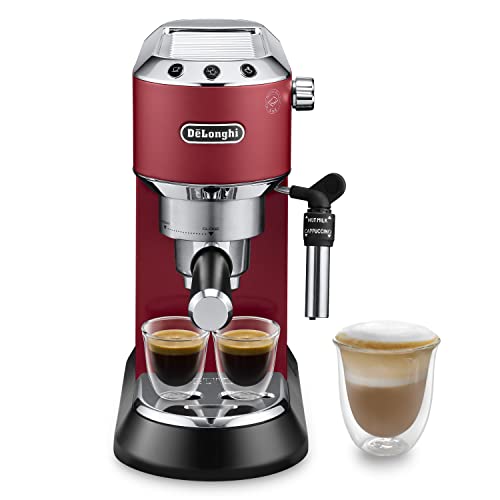How to Use a Coffee and Espresso Maker
A coffee maker produces shots of pressured water that is forced through finely ground, tightly packed espresso beans. The result is a highly flavored drink with a thick crema that is topped with.
Some machines allow you to alter the strength of your drink by using grounds or pods, while others steam milk for lattes or cappuccinos. You can even find an oven-based version that functions as a moka pot.
1. Guide to Buying

The most efficient espresso and coffee maker is more than just an appliance that pours hot water over grounds--it's a piece of equipment that can help you make high-quality coffee in the comfort of your own home. There are a lot of options in this area and it can become overwhelming. However, there are some things to take into consideration when selecting the best machine.
Understanding the different brewing methods is the first step. Certain machines employ gravity to filter the water through grounds, while others use the aid of a pump. These differences could affect the final flavor profile, as well as the cost.
While the most advanced coffee-and-espresso makers might have digital controls and adjustable settings, they're generally the most expensive. Therefore, it's crucial to consider how often you'll use the coffee-maker and espresso maker and whether the extra cost is worth the added convenience and control.
Semiautomatic models are offered at a lower cost and provide an alternative between manual and automation. They require the user to perform some work by hand, including grinding and tamping. However they also permit more control over making brews and are generally cheaper than fully automated models.
2. Instructions
It is simple to use the Espresso maker and coffee maker. The most crucial step is choosing the right ingredients and then preparing the machine. It is best to use freshly ground coffee beans, which have been ground on a burr mill that is specifically designed for espresso. The grinder creates an even, fine powder that releases the best flavor from the beans. You can use a steam wand for capspuccinos and lattes.
You will need to turn the espresso machine on and allow it to warm up before making any drinks. This can take several minutes, depending on your machine's size. It is essential to ensure that the machine heats evenly. This process is accelerated by pulling a blank, which allows you to run the machine with no grounds in the portafilter. This not only preheats your cup but also flushes out the group head to avoid the buildup of dirty water.
Once your machine is preheated, add the ground coffee into the portafilter. The next step is to tamp the grounds to make sure they are packed evenly and tightly. You can purchase the tamper on the internet or from a variety of espresso retailers. Once Related Homepag done, you can turn on the espresso machine and place one small cup beneath each spout. To brew your espresso, simply switch the control panel to the espresso position. This activates the micro-switches, which start the pump and the heating chamber, which pushes hot water through the grounds and out of the spouts.
3. Ingredients
A coffee or espresso machine can create a wide variety of drinks. These are the most versatile brewing devices. They can be used to create both espresso and drip drinks.
Espresso is a drink that is concentrated that is made by pushing hot water through finely ground coffee beans in a brief amount of time. Espresso is usually more sweet and thicker than regular coffee. It's also an excellent way to taste flavors that are more complex than the flavors in drip coffee, however it's not for everyone.
The best espresso is dark-roasted and a bit coarsely ground to maximize flavor extraction. Vigil advises you to "bloom" your coffee before making it by pouring a splash of hot water over the coffee grounds and then letting it sit for 20-30 minutes (releases the flavors). After adding the rest of the hot water, you'll use the machine's pressure to push the water through the grounds.
Certain machines are better than others. This is why some espresso and coffee makers are known for being difficult to use. With a little practice, you will be able to create your own espresso of cafe quality in the blink of an eye.
There are other ways to make almost-espresso using a machine, for example using siphons (a fancy glass device that utilizes the vapor pressure to soak the grounds in hot water). However, this is labor-intensive and time-consuming.
4. Preparation
Make sure your espresso maker is preheated and connected before you begin using it. You want the water to remain at the same temperature throughout your brewing to get as much flavor as you can. It's also a good idea to "bloom" or pour a little hot water onto the grounds of the coffee for 30 seconds. This will let out any carbon dioxide trapped in the beans and help your espresso taste better.
Once the brew cycle is completed, take out the portafilter and serve. You can use your espresso maker to prepare traditional single or double shots of espresso, or make use of a milk frother or steam wand to craft cafe favorites such as cappuccinos and lattes. Add a bit of sugar to your espresso shot to create a sweeter and more decadent drink.
You can utilize your espresso maker to brew regular coffee as well however you'll need utilize a filter because the majority of models don't have the capacity to make a full pot. To make a good pot of coffee, you must start with freshly coffee beans that have been ground to the proper consistency.
You can also experiment with different kinds of water. Hard water is rich in minerals that can cause mineral buildup, which results in a less flavorful brew. Water that is soft or filtered will reduce this buildup.
